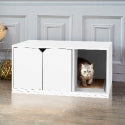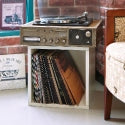Our home is our sanctuary. It is where we return to again and again for comfort, solace, rest, nourishment, etc. Whether you have children or not, your home should be a healthy place. You may not spend the majority of your woken hours there, but toxins, even while you sleep, contribute to both physical and mental health problems.
If you are building a new home, it is pretty simple to go green. Many alternatives now exist. From safer paints to wool carpeting, you don't have to rely on synthetic, toxic materials. Although it may cost more to go the eco-friendly route, it is worth it in the long run for both your health and the planet's
Remodeling an existing home can be a bit trickier than new construction, as extra precaution should be used when removing toxic building materials like asbestos tiles and fiberglass insulation. Most of us are not going to go to this extent and you don't have to tear apart your home or install an alternative energy system to build a safer home for your family. Start with small, simple steps. Eventually you will get to the bigger stuff.
My own home is a mixture of eco-friendly and more traditional elements. We did build our home from salvage timber. We did use only eco-friendly paints on the interior walls. Some of our insulation is made from recycled cotton. We do live
off-the-grid. What I think matters more than these green architectural features is how you fill your home.
One of the most basic places to start building a safer home for your family are your cleaning supplies. When my house is clean, I feel good. Unfortunately, most products used to clean our homes are highly toxic, perhaps the most dangerous chemicals in your house. That pine fresh scent isn't a good thing!
It's pretty simple to make your own cleaning supplies.
Healthy Child Healthy World has great recipes making your own cleaners. All you really need is vinegar, baking soda, and lemon juice, although I find plain water works great too. If you feel you need some soap, Dr. Bronner's is a safe, good multi-purpose cleaner. If you feel you need specific products, like for cleaning toilets or windows, there are a lot of eco-friendly products available now at health food stores and many mainstream grocery stores from brands such as Seventh Generation. Of course, don't forget the laundry. Choosing an eco-friendly, natural laundry detergent is also essential in keeping your home safe.
Beyond the products you use to clean your home, the interior of your home is another place to consider. Only use paint that is non-toxic and low in
VOCs Typical household paint may contain upwards of 300 known
toxic chemicals.
Consider purchasing eco-friendly furniture, especially mattresses. Think of how much time you spend in your bed, then consider that each mattress has at least five pounds of chemicals! The
Wool Bed Company explains:
These nasty chemicals you’ll find in your traditional, mass produced mattress include Boric Acid (also known as roach killer), Antimony (similar to arsenic), and Decabromodiphenyl Oxide, or DBDPO. These chemicals have been known to cause reproductive and developmental issues, heart, lung, and kidney damage, and even cancer. Inhaling these chemicals on a regular basis is extremely toxic to our bodies and will cause health issues until we resolve the problem.
In my home, all of our mattresses are eco-friendly, but our couches are not. I don't advise families throw out all of their furniture. That would not be very eco-friendly. I do advise that when you are purchasing new furniture, you use chemical-free as a criteria. New carpeting and couches are notorious for making people ill. Anything with a "new" smell should be avoided.
Finally, you cannot build a safer, eco-friendly home for your family without considering the kitchen.
Non-stick cookware should be tossed out immediately. A majority of the food in your cupboards and refrigerator should be organically grown. Less chemicals means a greener home and a healthier family.
It can feel overwhelming at times when you start to look around your home at all of the toxins. There are simple steps you can take immediately, such as using
houseplants to improve indoor air quality and switching to green cleaning products. You don't need to take out a second mortgage and completely gut your home to create a safer environment, just seek out greener products when replacing your old ones. Step by step this will lead you to a healthier home.















